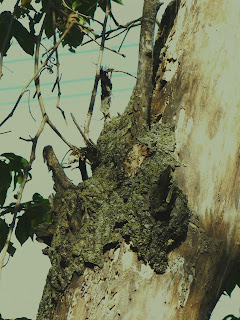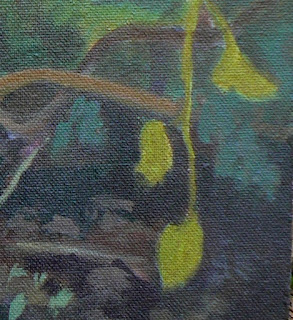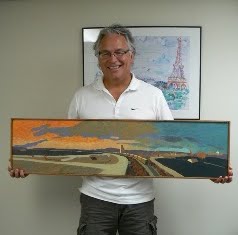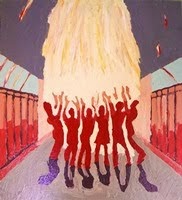After lunch and a nap, I was ready to T-R-Y another location. Today, Thursday, Sept. 3rd I worked from 2:00 to 4:00 pm on this "going up" piece.
With my wooden easel tied up by the pond, I tried a temporary easel to hold up my cradled panel. I used an iron planter post. After several tries and moving the post around, the panel was balanced on the hook, and the post leaned forward toward me, but kept the panel elevated fine the rest of that first afternoon. Ha.
To be sure, this was an extreme experiment. Could I paint something very close to me - that went up up up - without the aid of a preliminary drawing? The answer to that remained to be seen.

This is what is beside me. Shows left vertical branch and some of the upper foliage.
Above me. Shows crossing vines with light and darker leaf nets behind it.
The tip top branches in the sky. The labyrinth of crossing illumined leaves.
Close up of trunk with olive green bark at a juncture.
What will I squeeze onto my 43 by 34 inch panel?
Because of what I learned from two other paintings, I returned to this work a week later Wednesday, Sept. 16th, from 2:00 to 4:40 pm. See the fresh paint, next. Double click to see enlarged. Compare with previous states.
The seven videos gives you an idea of the time I am spending and practices I go through. Like, spraying down the area and my clothing with bug spray. The looking back and forth at the subject. And so forth.
.
Going Up 2. Fourteen minutes.
.
Going Up 2. Fourteen minutes.
Going Up 3. Eleven minutes. During the course of the video notice how the light changes from cloudy to bright. Light changes the subject you paint outdoors. The artist paints in an ever changing environment.
.
.
Going Up 4. Four minutes. The next day, Friday, Sept. 4th, I worked in the afternoon again from 1:00 to 3:00 pm, or there about. I started out with the temporary easel, but found out once I started to paint that it wasn't going to work for me this day. Sigh.
.
.
Going Up 5. Thirty-five seconds. Ooops.
.
.
Going Up 6. Fourteen minutes. With the panel on the regular easel I went back to work. On this second afternoon the painting went through many changes. (See next photos. Double click to enlarge)
.
.
Going Up 7. Five minutes. By the time I stopped for the day, I had painted out much of the painting. Down to what I could call essentials.
.
On Saturday, Sept. 5th, I spoke about this work. Four minutes.
Because of what I learned from two other paintings, I returned to this work a week later Wednesday, Sept. 16th, from 2:00 to 4:40 pm. See the fresh paint, next. Double click to see enlarged. Compare with previous states.




































































